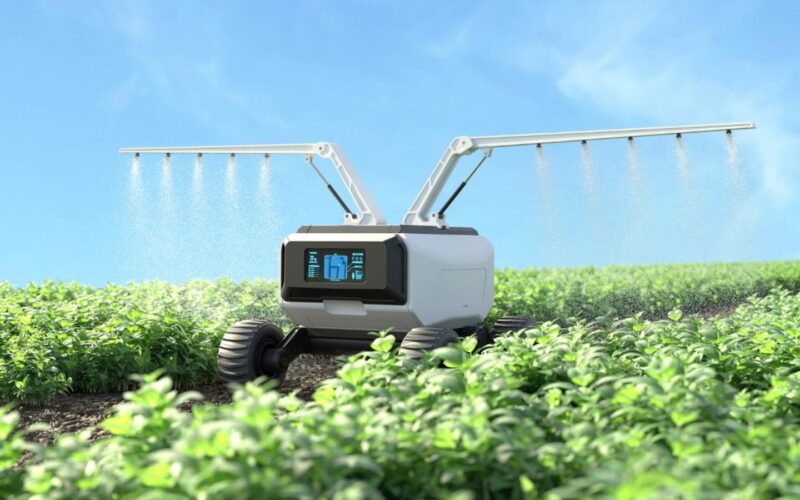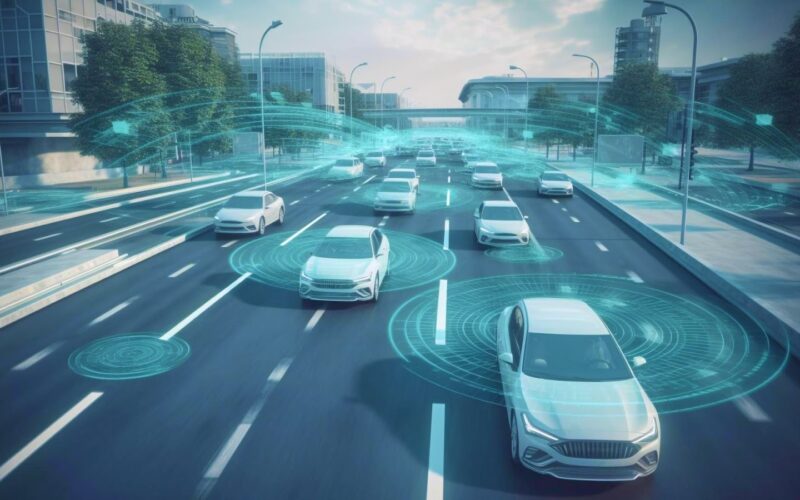What if farming could be more efficient, sustainable, and smarter? Thanks to technology, this is no longer just a concept; it’s happening right now. Technology and farming are coming together in innovative ways, transforming how crops are grown, managed, and harvested.
As the global demand for food continues to rise, the need for smarter, more efficient farming practices has never been more urgent. With advancements in artificial intelligence, drones, and precision farming, modern agriculture is taking a massive leap toward sustainability and productivity.
In this blog, we’ll explore how these technologies are revolutionizing the agricultural industry and paving the way for a new era of farming.
TL;DR
- From AI and agricultural drones to precision farming and robotics, these innovations are making agriculture more innovative, more efficient, and more sustainable.
- Precision farming uses data-driven insights for resource optimization, leading to reduced waste and increased crop yields.
- AI and machine learning predict crop health, optimize planting schedules, and improve decision-making, saving time and resources.
- Blockchain technology ensures transparency in the food supply chain, building consumer trust and increasing food safety.
- Companies like Walmart, Dusun IoT, and Nature Fresh Farms are already utilizing technology to enhance sustainability and boost profitability.
The Challenges in Traditional Farming
While farming has evolved over centuries, many traditional farming methods still face significant challenges. Despite advances in technology, the agricultural sector continues to grapple with inefficiencies, resource wastage, and environmental issues that hinder its potential for growth and sustainability.
Let’s break down these major pain points:
1. Slow Adoption of Technology
Many farms, especially small and medium-sized ones, are still heavily reliant on outdated methods. While larger farms often have the capital to invest in modern technologies, smaller farms may struggle to keep up.
For instance, without automated irrigation systems, farmers may be manually managing water usage, leading to waste and inefficiency. Technology solutions such as smart sensors and automated irrigation systems can greatly reduce these inefficiencies, but widespread implementation remains a challenge.
2. Resource Wastage
In traditional farming, resource management often lacks precision. Water, fertilizers, and pesticides are frequently used inefficiently, leading to overuse and environmental damage.
In regions with water scarcity, overuse can exacerbate the problem, creating long-term challenges for both farmers and the environment. Without precise data on soil health, moisture levels, or pest presence, farmers cannot optimize resource usage, resulting in both economic and environmental costs.
3. Climate and Environmental Issues
Farmers today face an unpredictable climate with extreme weather conditions like droughts, floods, and temperature fluctuations that affect crop yields. Soil degradation, along with changing weather patterns, makes it even more difficult for farmers to grow crops effectively and efficiently.
As the global climate crisis deepens, these environmental challenges threaten food security and further stress agricultural systems. In addition, traditional farming practices often lead to soil depletion and poor soil health.
Without the ability to track environmental changes in real-time, farmers can struggle to adjust their practices accordingly, potentially leading to crop loss or reduced productivity.
While these challenges persist, technology offers promising solutions. Let’s explore how innovations like precision farming, drones, and AI are not just addressing these issues but revolutionizing the way agriculture is done.
How Technology and Farming Are Changing the Landscape?
Technology is actively transforming farming. From precision farming to automation and AI-driven solutions, these advancements are enabling farmers to work smarter, not harder.
Let’s explore some of the most innovative technological solutions that are reshaping agriculture.
1. Precision Farming
Precision farming uses data analytics and IoT devices to help farmers make better decisions. By using sensors and real-time data, farmers can monitor everything from soil health and moisture levels to weather conditions and crop growth.
This allows for more accurate, targeted farming techniques that minimize waste and improve crop yields.
- For example, farmers can now deploy smart irrigation systems that adjust water usage based on soil moisture levels and weather forecasts, reducing water waste.
- Similarly, fertilizers can be applied precisely where they are needed, reducing both environmental impact and cost. Precision farming empowers farmers to make data-driven decisions that enhance productivity while conserving resources.
2. Drones and Aerial Imaging
Drones are revolutionizing how farmers monitor their fields. By providing real-time aerial imagery, drones enable farmers to assess crop health, track growth, and identify areas in need of attention, such as pest infestations or irrigation issues.
This allows for targeted interventions, improving both the health of the crops and the efficiency of farming operations.
- In addition, drones can be used to apply fertilizers or pesticides with pinpoint accuracy, reducing the amount of chemicals sprayed and minimizing environmental harm. They can cover vast areas in a short period, making them ideal for large-scale farms.
3. AI and Machine Learning
ML and AI in agriculture are making a significant impact on farming. By analyzing large sets of data, from weather patterns to soil health, AI helps farmers predict crop yields, detect diseases early, and optimize planting schedules.
- AI can also be used to analyze satellite imagery to assess the health of crops, offering invaluable insights for timely interventions.
- ML algorithms can learn from historical data to improve farming practices year after year. These tools help farmers make smarter decisions and reduce reliance on guesswork.
4. Automation and Robotics
Robotics and automation are the future of farming. From automated harvesting machines to robotic weeders and planting systems, automation is making farming more efficient and less labor-intensive. Robotic harvesters can work around the clock, harvesting crops faster than human laborers, while automated weeders reduce the need for manual labor and chemicals.
- Moreover, automated systems can also be used for planting, watering, and packaging crops, freeing up time for farmers to focus on other critical aspects of their business.
- These technologies not only reduce labor costs but also minimize human error and improve operational efficiency.
Ready to embrace the future of farming? Explore Codewave’s AI & ML development services to streamline your farming operations and increase productivity.
Now that we’ve seen how technology is reshaping farming, it’s time to focus on the tangible benefits. From increased efficiency to cost savings and sustainability, these advancements aren’t just improving practices but transforming outcomes.
The Benefits of Technology in Farming
Integrating technology into farming isn’t just about keeping pace with modern trends. It’s about unlocking substantial, tangible benefits that directly improve productivity, sustainability, and profitability.
Technology is the catalyst driving transformative change across agriculture. Here’s how:
1. Increased Efficiency
Agriculture has always been time-intensive, but technology is drastically reducing the time and resources spent on essential tasks.
- Automation – from AI-powered systems that predict harvest times to sensor-driven irrigation systems that adjust in real-time based on soil moisture – has made farming operations smarter.
- The result? More precise applications of water, fertilizers, and pesticides, all leading to improved productivity with less waste.
Farmers can now make real-time, data-backed decisions that keep operations running smoothly without unnecessary delays.
2. Sustainability
As the agricultural sector faces mounting pressure to feed a growing global population, sustainability is no longer a luxury but a necessity. Technology enables farmers to produce more food with fewer resources.
- Precision farming ensures that water, fertilizers, and pesticides are used only where needed, significantly reducing waste and environmental harm.
- Drones and IoT devices help farmers optimize inputs, decreasing reliance on harmful chemicals and minimizing soil depletion.
By embracing these technologies, farmers not only meet modern consumer expectations for sustainable practices but also improve long-term soil health and water conservation.
3. Cost Savings
While the upfront investment in agricultural technology can be significant, the cost savings and return on investment are undeniable.
- Robotic harvesters, for instance, can replace entire crews of workers, lowering labor costs.
- Moreover, AI-powered systems can help predict crop diseases and weather patterns, preventing losses from poor planting decisions or unexpected climatic events.
Data-driven agriculture leads to smarter resource management, which directly impacts the bottom line.
4. Better Crop Yield and Quality
Ultimately, the most visible impact of technology in farming is the improvement in both the quality and quantity of crops.
- With AI and ML, farmers can predict optimal planting times, track plant health, and detect early signs of disease or pests. This level of precision leads to healthier crops, higher yields, and improved quality that meets consumer demand for consistency.
- Furthermore, technologies like drone surveillance and IoT sensors ensure that farmers stay ahead of potential issues, leading to fewer crop losses and higher market value.
With these benefits, it’s clear that technology is not just enhancing farming but fundamentally changing it for the better.
Now, let’s explore practical examples and examine how these technologies have already made a measurable impact on farms worldwide.
Real-World Applications of Technology in Agriculture
The theoretical benefits of technology and farming are vast, but real applications are where the true power of these innovations becomes evident. Across the globe, farms of all sizes are adopting new technologies that enhance their efficiency, sustainability, and profitability.
Here are some concrete examples:
Blockchain for Supply Chain Transparency
1. Walmart’s Blockchain Initiative:
Walmart, in collaboration with IBM, developed a blockchain-based food traceability system to enhance transparency in the agricultural supply chain. This initiative aimed to track the origin of food products, ensuring quality and safety for consumers.
2. Pietro Coricelli’s Olive Oil Traceability:
Italian olive oil producer Pietro Coricelli utilized blockchain technology to trace the production and distribution of 4 million kilos of olive oil. This approach enhanced transparency and consumer trust in the product’s origin and quality.
AI-Driven Pest and Disease Management
1. AI Pest Detection in India:
Researchers at IIIT-Allahabad developed an AI-based system for real-time crop disease detection in Indian farms. The system analyzes leaf images and environmental data to identify diseases, achieving a detection success rate of up to 97.25%.
2. TMA Solutions’ Pest Detection System:
TMA Solutions implemented an AI-powered pest detection system that leverages advanced algorithms to identify and manage pest infestations in crops, aiding effective agricultural management.
IoT-Enabled Smart Greenhouses
1. Dusun IoT Greenhouse Monitoring:
Dusun IoT developed a greenhouse monitoring and control system that utilizes IoT devices to increase productivity and efficiency in smart agriculture. The system features sensors for temperature, humidity, and soil moisture, allowing for real-time monitoring and control.
2. GreenLab’s IoT-Based Smart Greenhouse:
GreenLab, a small-scale smart greenhouse, integrates IoT-based solutions to optimize energy consumption and ensure functionality during night and cloudy weather. The system includes a photovoltaic panel and a mobile application for data visualization and monitoring.
Automated Harvesting and Robotics
1. Nature Fresh Farms’ Robotic Tomato Harvesting:
Nature Fresh Farms, a leading greenhouse farm in North America, implemented an automated solution to harvest tomatoes. The system utilizes robotics and AI to meet increasing customer orders and overcome labor challenges.
2. IIT Kharagpur’s Agricultural Robot:
Researchers at IIT Kharagpur developed an advanced agricultural robot designed to detect plant diseases and precisely apply pesticides. The robot features a camera-based image analysis system for accurate crop health monitoring and pest control.
As these practical uses unfold, Codewave is here to guide your journey towards sustainable and efficient farming. Explore our portfolio to see how we can transform your agricultural operations.
While these real-world applications highlight the current success of technology in farming, the future promises even greater innovations. The next step is to explore what’s on the horizon for agricultural technology.
The Future of Farming with Technology
The future of farming is unfolding in exciting and groundbreaking ways. From robotics to AI-driven farming systems and sustainable agricultural practices, the opportunities for farmers to thrive while addressing global food security challenges are endless.
Here’s a look at what the future holds for technology in agriculture:
1. Robotics and Autonomous Machinery
Robots and autonomous machinery are set to revolutionize farming. Autonomous tractors and robotic harvesters will reduce the need for manual labor, increasing productivity and precision. These robots will also aid in monitoring soil health and ensuring sustainable farming practices.
2. AI and Predictive Analytics
AI will enhance farming through predictive analytics, helping farmers anticipate crop yields, diseases, and market trends. AI will allow smarter decision-making based on weather, soil, and crop health data, optimizing farming practices.
3. Smart Farming and IoT Integration
IoT devices will connect farms, automating everything from irrigation to crop monitoring. Real-time data from sensors will optimize resource use, making farming more efficient and sustainable, especially in precision agriculture.
4. Blockchain and Supply Chain Transparency
Blockchain will ensure greater transparency in food supply chains, allowing for the tracking of products from farm to table. This will increase food safety, reduce costs, and improve market access by eliminating intermediaries.
These are just the beginning. The next wave of agricultural innovation will help farmers not only meet the growing global demand for food but also do so in an environmentally conscious way.
However, with a variety of technologies available, it can be overwhelming to know where to start or how to integrate them seamlessly into your farming operations. That’s where Codewave comes in.
Why Codewave is Your Ideal Partner in Implementing Agricultural Technology?
As the demand for more sustainable, efficient, and high-yield farming grows, it’s essential to adopt the right technologies and integrate them effectively into your operations.
At Codewave, we specialize in designing and deploying technology solutions tailored to your specific farming needs. From selecting the right technologies to ensuring smooth integration, our expert team helps ensure that your farming operations are ready for the future.
Here’s why you should choose Codewave:
- Specialized Technology Solutions: We customize technology to align perfectly with your farm’s specific goals, ensuring that every tool works in harmony to drive results.
- Scalable & Future-Ready: Our solutions are designed to grow with your business. As agricultural technology evolves, we ensure that your systems remain adaptable and able to handle emerging challenges and opportunities.
- Seamless Integration: Whether you’re upgrading existing systems or starting from scratch, we make sure the integration of new technologies is smooth, minimizing disruption and optimizing your operations.
- Real Results: With a proven track record of successful technology implementations, Codewave delivers real, measurable results – whether it’s reducing costs, improving crop yield, or enhancing operational efficiency.
If you’re ready to tap into the potential of technology and revolutionize your farming practices, Codewave is here to guide you every step of the way.
Get a free consultation to explore how we can help transform your agricultural business with innovative technology.
FAQs
1. What are the main technologies transforming modern agriculture?
Key technologies reshaping agriculture include Artificial Intelligence (AI) for predictive analytics, Internet of Things (IoT) for real-time monitoring, Robotics for automation, Blockchain for supply chain transparency, and Drones for precision farming. These innovations enhance efficiency, reduce costs, and improve crop yields.
2. How does AI improve farming practices?
AI enhances farming by analyzing data from various sources to predict crop health, optimize irrigation schedules, and detect pests early. For instance, AI-powered tools like Virtual Agronomist have helped farmers in Kenya increase yields by providing tailored fertilization advice.
3. What role does IoT play in agriculture?
IoT devices, such as soil moisture sensors and climate monitors, collect real-time data that farmers use to make informed decisions about irrigation, fertilization, and pest control. This data-driven approach leads to resource optimization and increased crop productivity.
4. Can blockchain technology ensure food traceability?
Yes, blockchain provides a secure and transparent way to trace the journey of agricultural products from farm to table. This technology helps verify the authenticity and quality of food, building consumer trust and ensuring food safety.
5. Are drones effective in modern farming?
Drones are highly effective in modern farming. They are used for aerial surveillance, crop health monitoring, and precise pesticide application. Studies have shown that drone usage can reduce water consumption for spraying by up to 90% and increase crop yields by significant margins.
Codewave is a UX first design thinking & digital transformation services company, designing & engineering innovative mobile apps, cloud, & edge solutions.







